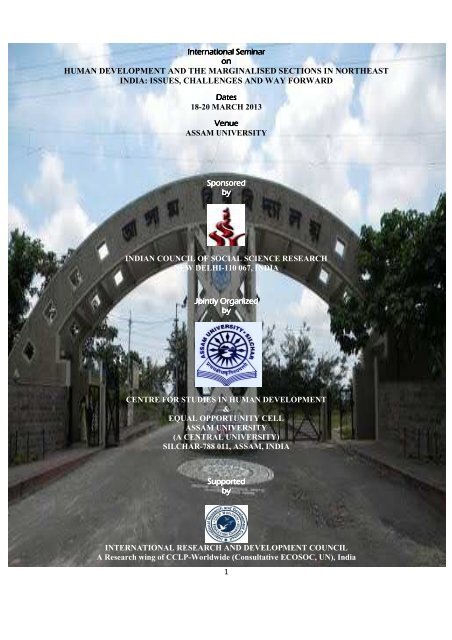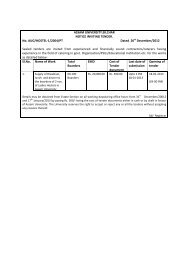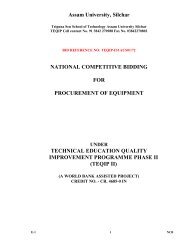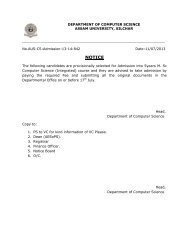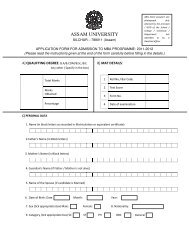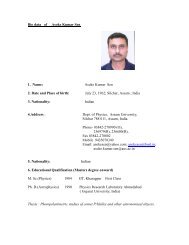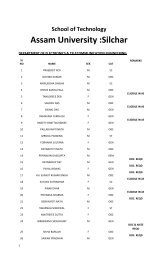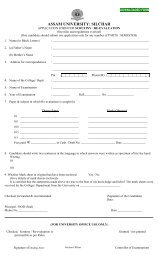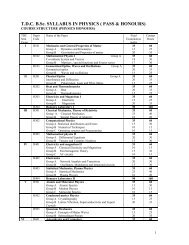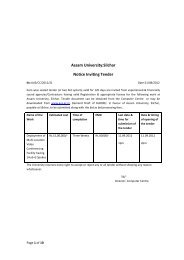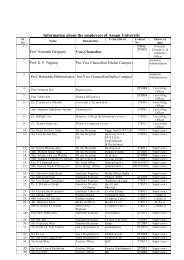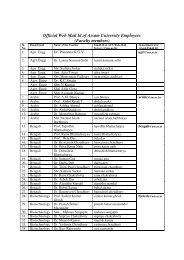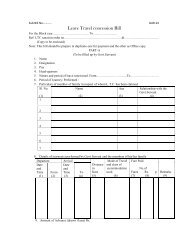International Seminar on Human Development ... - Assam University
International Seminar on Human Development ... - Assam University
International Seminar on Human Development ... - Assam University
Create successful ePaper yourself
Turn your PDF publications into a flip-book with our unique Google optimized e-Paper software.
<str<strong>on</strong>g>Internati<strong>on</strong>al</str<strong>on</strong>g> <str<strong>on</strong>g>Seminar</str<strong>on</strong>g><strong>on</strong>HUMAN DEVELOPMENT AND THE MARGINALISED SECTIONS IN NORTHEASTINDIA: ISSUES, CHALLENGES AND WAY FORWARDDates18-20 MARCH 2013VenueASSAM UNIVERSITYSp<strong>on</strong>soredbyINDIAN COUNCIL OF SOCIAL SCIENCE RESEARCHNEW DELHI-110 067, INDIAJointly OrganizedbyCENTRE FOR STUDIES IN HUMAN DEVELOPMENT&EQUAL OPPORTUNITY CELLASSAM UNIVERSITY(A CENTRAL UNIVERSITY)SILCHAR-788 011, ASSAM, INDIASupportedbyINTERNATIONAL RESEARCH AND DEVELOPMENT COUNCILA Research wing of CCLP-Worldwide (C<strong>on</strong>sultative ECOSOC, UN), India1
Organising CommitteePatr<strong>on</strong>Prof. Somnath Dasgupta, Vice Chancellor, <strong>Assam</strong> <strong>University</strong>, Silchar.ChairmanProf. K V Nagraj, Pro-Vice Chancellor, Dorgak<strong>on</strong>a Campus, <strong>Assam</strong> <strong>University</strong>, Silchar.Organising SecretaryProf. G Ram, Professor of Sociology, Director, Centre for Studies in <strong>Human</strong> <strong>Development</strong>, & Co-ordinator, Equal Opportunity Cell,<strong>Assam</strong> <strong>University</strong>, Silchar.MembersProf. Gopalji Mishra, Professor of Social Work, Dean, School of Social Sciences & Chairman, Advisory Committee for Centre for Studies in<strong>Human</strong> <strong>Development</strong>, <strong>Assam</strong> <strong>University</strong>, Silchar.Prof. A M Bhuiya, Professor of Arabic, Dean, School of English and Foreign Languages & Chairman, Committee for Equal Opportunity Cell,<strong>Assam</strong> <strong>University</strong>, Silchar.Prof. Niranjan Roy, Professor of Ec<strong>on</strong>omics, Director, Directorate of Internal Quality Assessment & Member, Advisory Committee for Centrefor Studies in <strong>Human</strong> <strong>Development</strong>, <strong>Assam</strong> <strong>University</strong>, Silchar.Prof. R R Dhamala, Department of Political Science, & Member, Advisory Committee for Centre for Studies in <strong>Human</strong> <strong>Development</strong>, <strong>Assam</strong><strong>University</strong>, Silchar.Prof. Ashesh K Das, Department of Ecology and Envir<strong>on</strong>mental Science & Member, Advisory Committee for Centre for Studies in <strong>Human</strong><strong>Development</strong>, <strong>Assam</strong> <strong>University</strong>, Silchar.Prof. G P Pandey, Professor of Mass Communicati<strong>on</strong>, Dean, School of Creative Studies & Member, Advisory Committee for Centre forStudies in <strong>Human</strong> <strong>Development</strong>, <strong>Assam</strong> <strong>University</strong>, Silchar.Prof. Dipankar Purkayastha, Department of English, <strong>Assam</strong> <strong>University</strong>, SilcharProf. B P Mishra, Retired Professor of Ec<strong>on</strong>omics (North Bengal) & Advisor to Govt of West Bengal for Higher Educati<strong>on</strong>, Ex-Chairman,Centre for Studies in <strong>Human</strong> <strong>Development</strong>, <strong>Assam</strong> <strong>University</strong>, SilcharDr. Arup Barman, Associate Professor, Department of Business Administrati<strong>on</strong> & Member, Committee for Equal Opportunity Cell, <strong>Assam</strong><strong>University</strong>, Silchar.Dr. Ratna Huirem, Assistant Professor, Department of Social Work & Member, Committee for Equal Opportunity Cell, <strong>Assam</strong> <strong>University</strong>,Silchar.Dr. Nil Ratan Roy, Assistant Professor, Department of Educati<strong>on</strong> & Member, Committee for Equal Opportunity Cell, <strong>Assam</strong> <strong>University</strong>,Silchar.Mrs. D Mary Kim Haokip, Assistant Professor, Department of Linguistics & Member, Committee for Equal Opportunity Cell, <strong>Assam</strong><strong>University</strong>, Silchar.Dr. Arunjyoti Nath, Assistant Professor, Department of Ecology and Envir<strong>on</strong>mental Science & Member, Committee for Equal OpportunityCell, <strong>Assam</strong> <strong>University</strong>, Silchar.Dr. Raju Mandal, Assistant Professor, Department of Ec<strong>on</strong>omics & Member, Committee for Equal Opportunity Cell, <strong>Assam</strong> <strong>University</strong>,Silchar.Dr Partha Sarkar, Assistant Professor, Mass Communicati<strong>on</strong>, Department of Mass Communicati<strong>on</strong>, <strong>Assam</strong> <strong>University</strong>, Silchar.Mr Shubhadip Dhar, Assistant Registrar, Finance Branch, <strong>Assam</strong> <strong>University</strong>, Silchar.Mr Niharendu Dhar, Assistasnt Regisrar (Estate), <strong>Assam</strong> <strong>University</strong>, Silchar.About the OrganizersCentre for Studies in <strong>Human</strong> <strong>Development</strong> is an interdisciplinary research-cum-academic centre of <strong>Assam</strong> <strong>University</strong> and Equal OpportunityCell is an acti<strong>on</strong>-oriented cell of the university organizing various programmes for training and skill-development of the students, scholars andemployees from various marginalized groups in the university and its vicinity and also for community orientati<strong>on</strong> <strong>on</strong> important social andnati<strong>on</strong>al issues. The two offices are jointly organizing an internati<strong>on</strong>al seminar during 18-20 March 2013 <strong>on</strong> the theme <strong>Human</strong> <strong>Development</strong>and the Marginalised Secti<strong>on</strong>s in Northeast India: Issues, Challenges and Way Forward. The seminar is sp<strong>on</strong>sored by ICSSR, New Delhi,and supported by IRDC.IRDC is a research wing of CCLP-Worldwide, which c<strong>on</strong>ducts research programs <strong>on</strong> development through educati<strong>on</strong> and supportsdevelopmental thinkers in developing countries to resolve the global issues related to educati<strong>on</strong>, peace, and sustainability and encouragessharing of knowledge with policymakers, researchers, and communities around the world to bring choice based change through innovativeeducati<strong>on</strong> for sustainability and livelihood. The Chambers of Computer Logistics People-Worldwide (CCLP-Worldwide), a Global CivilSociety, has recently got a special c<strong>on</strong>sultative status to ECOSOC-UN in the Year 2012. This organizati<strong>on</strong> promotes the <str<strong>on</strong>g>Internati<strong>on</strong>al</str<strong>on</strong>g>Educati<strong>on</strong> Charter – a declarati<strong>on</strong> of fundamental principles guiding youth-educati<strong>on</strong> worldwide in the 21st century.2
Thematic PerspectiveThe human populati<strong>on</strong>s, ever-dispersing within and across nati<strong>on</strong>al/ geographical borders, all through the historical times, have added to ethniccomplexity of all the societies, especially the large societies like India, USA, Canada, UK and others. Amidst various groups of such societies,<strong>on</strong>e perceives a c<strong>on</strong>sciousness of kind or the process of self-identificati<strong>on</strong>, ie, <strong>on</strong>e’s labeling based <strong>on</strong> a single or combinati<strong>on</strong> of factors likelanguage, religi<strong>on</strong>, caste, community, race, tribe, regi<strong>on</strong>, sect, sub-culture, symbols, traditi<strong>on</strong>s, comm<strong>on</strong> historical experience, creed, nati<strong>on</strong>alminority, ritual, dress, diet, boundary and nati<strong>on</strong>al origin which gives a group ethnic or self identity- a set of the group’s distinct socio-culturalpractices learnt through a particularistic socializati<strong>on</strong>. As a result, there emerge diverse ethnic/cultural groups, each, perceiving itself in amajority-minority or dominant-subordinate relati<strong>on</strong>ship based <strong>on</strong> the size of populati<strong>on</strong>, settlement pattern, social interacti<strong>on</strong>s, culture andec<strong>on</strong>omy. India makes a society of about 4635 communities, comprising 2,000 to 3,000 caste groups, about 60,000 of syn<strong>on</strong>yms of titles and subgroupsand about 40,000 endogenous divisi<strong>on</strong>s (K S Singh 1992). All through the history, Indian sub-c<strong>on</strong>tinent as a whole has experiencedmultiple overlaying of the populati<strong>on</strong>s dispersing in the South and South East Asia. The stepped up trans-border and internal circulati<strong>on</strong> of peoplein search of better livelihood opportunities, especially in the post-Independence period, has given rise to more complex ethnic formati<strong>on</strong>s inIndia, particularly in its Northeastern regi<strong>on</strong> which comprises eight states; namely, Arunachal Pradesh, <strong>Assam</strong>, Manipur, Meghalaya, Mizoram,Nagaland, Tripura and Sikkim. Northeast India abuts with Bhutan and China in the north, China and Myanmar in the east, and India’s anotherstate, West Bengal, and another country, Bangladesh, in the west. It c<strong>on</strong>stitutes 7.97% of India’s total area and 3.77% of its total populati<strong>on</strong>. Thehilly terrains cover 72% of its total area. A large number of groups interspersed in the diverse terrains form almost all the ethnic varieties of race,life style, culture, language, religi<strong>on</strong>, beliefs and traditi<strong>on</strong>. Mainly five factors compose the ethnic plurality in the regi<strong>on</strong>; namely, (i) race (ii)tribe, (iii) caste and /or n<strong>on</strong>-tribe, (iv) language and (v) religi<strong>on</strong>. Historically, the regi<strong>on</strong> has witnessed mobile populati<strong>on</strong>s of multiple andinterspersed ethnic groups, competing for dominance and development in different locales. This ethnic heterogeneity serves a reservoir for socioculturalrichness, <strong>on</strong> the <strong>on</strong>e hand, and it pushes certain groups to the social margins, <strong>on</strong> the other hand. Hence, creating a feeling of relativedeprivati<strong>on</strong> am<strong>on</strong>g the groups engaged in interacti<strong>on</strong>s for producti<strong>on</strong> and governance. In the given ethnic make-up of the regi<strong>on</strong>, the actors ofdemocratic politics like political parties and leaders compete for attaining power by mobilizing people’s support <strong>on</strong> the basis of ethnic identities,<strong>on</strong> the <strong>on</strong>e hand, and the people compete for their stakes in governance to secure a bigger slice of development (producti<strong>on</strong>) <strong>on</strong> the same basis ofethnic identity, <strong>on</strong> the other hand. Thus, <strong>on</strong>e comes to witness the politics of underdevelopment and scarcity wherein people use their culturalresource, ethnic identity, as means to attain power, wealth and status, i e, material and n<strong>on</strong>-material gains. The result is perpetuati<strong>on</strong>,fragmentati<strong>on</strong> and c<strong>on</strong>flicts of identities as well as exclusi<strong>on</strong>, deprivati<strong>on</strong>, exploitati<strong>on</strong> and marginalizati<strong>on</strong> of certain groups. The marginalizati<strong>on</strong>of various groups is the outcome of cultural (ethnic) dominance over polity and ec<strong>on</strong>omy. Besides, the regi<strong>on</strong> also feels marginalized or alienatedfrom the rest of India.In Northeast India the salience of marginalizati<strong>on</strong> is apparent at two levels. First, the regi<strong>on</strong> as a whole is the marginalized, both, in subjectiveand objective meanings, i. e., the people of the regi<strong>on</strong> c<strong>on</strong>sider themselves deprived, excluded and backward as compared to the mainstream, <strong>on</strong>the <strong>on</strong>e hand, and many of the people from India’s mainland who have no idea of the regi<strong>on</strong> exclude it as an alien land, <strong>on</strong> the other. Thus, thereis c<strong>on</strong>stantly felt ‘otherness’ between the Northeast and the mainland. Sec<strong>on</strong>d, the communities in the regi<strong>on</strong> also c<strong>on</strong>struct the noti<strong>on</strong> of ‘other’am<strong>on</strong>g them, resulting into marginalizati<strong>on</strong> of various groups. The perceived marginalizati<strong>on</strong> at these two levels have given rise to insurgency ofvarious groups, resisting against the State and/ or a dominant group whereas the sec<strong>on</strong>d level of marginalizati<strong>on</strong> has additi<strong>on</strong>ally been a c<strong>on</strong>stantsource of c<strong>on</strong>flict between various groups within the regi<strong>on</strong>. In this dynamic situati<strong>on</strong> of homogenizati<strong>on</strong> of power with culture, the‘marginalized’ also appears to be complex and dynamic in the regi<strong>on</strong>. There is dichotomy of culture and power which can be redeemed <strong>on</strong>lythrough replacement of a culturally homogenized power by a politically homogenized culture and for such replacement the instrument of humandevelopment can be used. No doubt, during the past six decades of planned development the Indian State has presented development as soluti<strong>on</strong>,through use of technology and heavy capital investment, but it could not arrest people’s marginalizati<strong>on</strong> and solve the problems of isolati<strong>on</strong>,underdeveloped infrastructure, unemployment and insurgency in the regi<strong>on</strong>. In spite of huge funds allocated to the regi<strong>on</strong> under every plan, someof which often remain unutilized, special packages, grants-in-aid and grants extended to the Sixth Schedule areas created under IndianC<strong>on</strong>stituti<strong>on</strong> and a separate central Ministry of DoNER, human development till date is not so apparent. Above all, during the period ofglobalizati<strong>on</strong> the gap of the regi<strong>on</strong>’s states with the rest of India has further widened. Obviously it points to the <strong>on</strong>-going marginalizati<strong>on</strong> of theregi<strong>on</strong> as a whole as well as the implicit marginalizati<strong>on</strong> of various groups in the regi<strong>on</strong>. Internally displaced Chakmas and Reangs, migrants orimmigrants, tea garden communities, Adivasis, religious minorities, linguistic minorities, small tribes, hill tribes, Scheduled Castes, people inflood ravaged areas etc can be named am<strong>on</strong>g many of the marginalized secti<strong>on</strong>s which are having low level of human development in the regi<strong>on</strong>.This raises questi<strong>on</strong>s: What level of human development is obtained in the regi<strong>on</strong> vis-à-vis India as a whole? What human3
development status of the marginalized secti<strong>on</strong>s <strong>on</strong>e perceives in the regi<strong>on</strong>? What factor ultimately determines the human development ofthe marginalized people in the regi<strong>on</strong>? In the c<strong>on</strong>text of the efforts made thus far for uplift of the regi<strong>on</strong>’s people, the cause of theirperpetual marginality with low human development seems to narrow down to governance, the prominent actors of which currently aregovernment, n<strong>on</strong>-government organizati<strong>on</strong>s, market and civil society organizati<strong>on</strong>s. <strong>Human</strong> development which is in real sense a newapproach to empowerment of people can be used to overcome the deficiencies of the <strong>on</strong>-going development and governance.‘<strong>Human</strong> <strong>Development</strong>’ as a new paradigm of development theory brings people into the centre stage of development, c<strong>on</strong>sidering them thereal wealth of a nati<strong>on</strong> and quality of their life as end to be pursued through the means of Gross Domestic Product (GDP) or ec<strong>on</strong>omicgrowth. The United Nati<strong>on</strong>s <strong>Development</strong> Programme (UNDP), in its first report <strong>on</strong> human development (1990), c<strong>on</strong>ceived it as “enlargingpeople’s choices” which are varied and changing over time. The UNDP’s c<strong>on</strong>cept covers widely accepted three critical dimensi<strong>on</strong>s ofpeople’s well being; namely, (i) a l<strong>on</strong>g and healthy life, (ii) access to knowledge and skills and (iii) c<strong>on</strong>trol over resources to ensure a decentstandard of living. Taking into account the three broad parameters, the UNDP envisages measuring the people’s welfare by way ofc<strong>on</strong>structing composite <strong>Human</strong> <strong>Development</strong> Index (HDI). Recognizing the existence of gender disparity in development process the UNDPsubsequently developed Gender <strong>Development</strong> Index (GDI) and Gender Empowerment Measure (GEM) as well as <strong>Human</strong> Poverty Index(HPI) as a complement to HDI. These simple indices can easily gauge social or regi<strong>on</strong>al disparities in human development. <strong>Human</strong>development does not simply encompass human capacity building, i e, good health, more knowledge, higher incomes, etc but it also includesproper use of these capabilities (empowerment). In additi<strong>on</strong> to health, educati<strong>on</strong> and income people have other important choices likepolitical freedom, human rights, self respect, human security, political participati<strong>on</strong> and many more. People’s choices are found to varyaccording to ethnic group, religi<strong>on</strong>, place of residence etc. and even the people bel<strong>on</strong>ging to the same ethnic group or religi<strong>on</strong> differ in theirchoices according to place of residence, level of educati<strong>on</strong>, ec<strong>on</strong>omic status etc. Therefore, the existing indices and their methodology can beextended to measure any of human choices of any level or group. By measuring and assessing various choices of people and their well beinghuman development emerges as effective device to improve the quality of life of the deprived and marginalized secti<strong>on</strong>s. The countries in thedeveloped world like Canada, USA, U K and other west European countries as well as east European countries have been dealing withmulticulturalism and marginalizati<strong>on</strong>, <strong>on</strong> the <strong>on</strong>e hand, and the countries in the neighbourhood of India’s Northeast like China, Nepal,Bhutan, Myanmar and Bangladesh or the Southeast Asian countries falling in India’s ‘Look East Policy’ ambit do share experiences of acomm<strong>on</strong> cultural area, though with somewhat difference of political systems and governance. In the recent decades the c<strong>on</strong>cept of humandevelopment has emerged not <strong>on</strong>ly as a comm<strong>on</strong> tool for assessment of real development but also for improvement of quality of life of themarginalized people in various nati<strong>on</strong>s and cultures across the globe. Therefore, it calls for serious discussi<strong>on</strong>s <strong>on</strong> the status, issues,challenges and way forward in respect of human development am<strong>on</strong>g the marginalized secti<strong>on</strong>s of Northeast India by inviting cross-culturaland cross-nati<strong>on</strong>al perspectives of academics from the regi<strong>on</strong> itself, other parts of India, the neighbouring countries of the regi<strong>on</strong> and a fewfrom the developed, multicultural countries.ObjectivesThe specific objectives of the seminar are:• To assess the human development status of the marginalized secti<strong>on</strong>s in Northeast India• To identify the issues of human development am<strong>on</strong>g the marginalized secti<strong>on</strong>s in Northeast India• To assess the challenges to human development am<strong>on</strong>g the marginalized secti<strong>on</strong>s in Northeast India• To find out the way forward for human development am<strong>on</strong>g the marginalized secti<strong>on</strong>s in Northeast India• To utilize the cross-cultural and cross-nati<strong>on</strong>al perspectives <strong>on</strong> human development for the marginalized secti<strong>on</strong>s in Northeast India• To understand the methodological challenges associated with the measurement of human development in the c<strong>on</strong>temporary c<strong>on</strong>text ofNortheast India• To suggest policy measures for effective human development am<strong>on</strong>g the marginalized secti<strong>on</strong>s in Northeast IndiaSub-themesThe potential sub-themes of the seminar are as follows:• Culture, <strong>Development</strong> and Governance: Emerging Theoretical Frameworks• <strong>Human</strong> <strong>Development</strong> and the Marginalized Secti<strong>on</strong>s in India• <strong>Human</strong> <strong>Development</strong> and the Marginalized Secti<strong>on</strong>s in Northeast India• Gender, <strong>Human</strong> <strong>Development</strong> and the Marginalized Secti<strong>on</strong>s in Northeast India• Market, <strong>Human</strong> <strong>Development</strong> and the Marginalized Secti<strong>on</strong>s in Northeast India• State, <strong>Human</strong> <strong>Development</strong> and the Marginalized Secti<strong>on</strong>s in Northeast India• Civil Society, <strong>Human</strong> <strong>Development</strong> and the Marginalized Secti<strong>on</strong>s in Northeast India4
• NGOs/CBOs, <strong>Human</strong> <strong>Development</strong> and the Marginalized Secti<strong>on</strong>s in Northeast India• Inequalities, <strong>Human</strong> <strong>Development</strong> and the Marginalized Secti<strong>on</strong>s in Northeast India• Health and the Marginalized Secti<strong>on</strong>s in Northeast India• Educati<strong>on</strong> and the Marginalized Secti<strong>on</strong>s in Northeast India• Work Participati<strong>on</strong>/Employment and the Marginalized Secti<strong>on</strong>s in Northeast India• Poverty and the Marginalized Secti<strong>on</strong>s in Northeast India• Livelihood Rights and the Marginalized Secti<strong>on</strong>s in Northeast India• Shelter and the Marginalized Secti<strong>on</strong>s in Northeast India• Political Participati<strong>on</strong> and the Marginalized Secti<strong>on</strong>s in Northeast India• Informati<strong>on</strong> Flow/ Mass Media and the Marginalized Secti<strong>on</strong>s in Northeast India• Envir<strong>on</strong>ment and the Marginalized Secti<strong>on</strong>s in Northeast India• <strong>Human</strong> Security and the Marginalized Secti<strong>on</strong>s in Northeast India• <strong>Human</strong> <strong>Development</strong> and the Ethnic/Religious/Linguistic Minorities in Northeast India• <strong>Human</strong> <strong>Development</strong> and the Hill Communities in Northeast India• <strong>Human</strong> <strong>Development</strong> and the Scheduled Castes in Northeast India• <strong>Human</strong> <strong>Development</strong> and the Tea Garden Communities in Northeast India• <strong>Human</strong> <strong>Development</strong> and the Displaced Communities in Northeast India• <strong>Human</strong> <strong>Development</strong> and the Internal Migrants in Northeast India• <strong>Human</strong> <strong>Development</strong> and the Immigrants in Northeast India• Any other topic related to the theme of the seminarExpected OutcomeIt is expected that there will come out the status, issues, challenges/ problems and feasible way forward of human development formarginalized secti<strong>on</strong>s in the regi<strong>on</strong> and some c<strong>on</strong>crete recommendati<strong>on</strong>s will come out of the discourses for submissi<strong>on</strong> to the ICSSR andfor use of Government of India for policy making/ review purpose.Call for PapersAcademics, researchers, development actors, social workers etc are invited for presentati<strong>on</strong> of papers, discussi<strong>on</strong>s and discourses in thethree-day internati<strong>on</strong>al seminar. Participants are requested to send an abstract of their paper/ research article in not more than 250 words <strong>on</strong>the e-mail ID: cshdaus@rediffmail.com <strong>on</strong> or before 20 February 2013 al<strong>on</strong>g with the duly filled <str<strong>on</strong>g>Seminar</str<strong>on</strong>g> Registrati<strong>on</strong> Form. Participantscan also send the abstract in hardcopy to the Organizing Secretary. The abstract should focus <strong>on</strong> a topic related to any of the sub-themes or atopic relevant to the seminar; however, c<strong>on</strong>clusi<strong>on</strong>s should have relevance for human development of marginalized secti<strong>on</strong>s in the multiculturalNortheast India. Acceptance of abstracts will be communicated through email quickly. Abstracts of accepted papers will be includedin the Book of Abstracts to be brought out by the Organizing Committee. Therefore, it is earnestly requested to follow the deadline. Fullpapers will be circulated in the c<strong>on</strong>ference. Full paper not exceeding 3000 words is required to be submitted in soft copies (e-mailattachment / CD) <strong>on</strong> or before 10 March 2013. The papers presented in the seminar will be published in edited volumes of book. Guidelinesfor submissi<strong>on</strong> of abstracts and papers by authors organized in the following sequence:Abstract- Title of Paper (F<strong>on</strong>t Style- Times New Roman, Size-14); Author(s) Name (indicate the corresp<strong>on</strong>ding author with * mark,Designati<strong>on</strong>, Affiliati<strong>on</strong>, Ph<strong>on</strong>e, Email Address and C<strong>on</strong>tact Details). Then follows brief Objectives, Methodology and Findings; Followedby maximum 5 Key Words, within the limit of 250 words.Full Paper- Title (F<strong>on</strong>t Style- Times New Roman, Size-14), Introducti<strong>on</strong>-including brief Review, Brief Objectives, Methodology, Analysis,Results and Discussi<strong>on</strong> and C<strong>on</strong>clusi<strong>on</strong>. (All headings and text part must be in Times New Roman with 12 f<strong>on</strong>t size).Referencing- The referencing style should be APA format (Footnote also need reference with APA format).Line space – 1.5Margins- ’1’ inch <strong>on</strong> all sidesC<strong>on</strong>tent- in English and typed in Microsoft WordsImportant DatesLast Date for Abstract Submissi<strong>on</strong>: 20 February 2013Last Date for Full/Final Paper Submissi<strong>on</strong>: 10 March 2013Travel SupportParticipants are requested to manage travel support from their parent instituti<strong>on</strong>s.5
<str<strong>on</strong>g>Internati<strong>on</strong>al</str<strong>on</strong>g> <str<strong>on</strong>g>Seminar</str<strong>on</strong>g> <strong>on</strong>HUMAN DEVELOPMENT AND THE MARGINALISED SECTIONS IN NORTHEAST INDIA: ISSUES, CHALLENGESAND WAY FORWARD(18-20 March2013)Jointly Organised byCENTRE FOR STUDIES IN HUMAN DEVELOPMENT&EQUAL OPPORTUNITY CELLASSAM UNIVERSITY, SILCHAR-788 011, ASSAM, INDIASp<strong>on</strong>sored by ICSSR,INDIAN COUNCIL OF SOCIAL SCIENCE RESEARCH (ICSSR), NEW DELHI, New Delhi-110067REGISTRATION FORM1. Name:________________________________________________________2. Sex:__________________________________________________________3. Designati<strong>on</strong> and Affiliati<strong>on</strong>:_______________________________________4. Address for Corresp<strong>on</strong>dence:_____________________________________________________________________________________________________________________________________________________________Ph<strong>on</strong>e:____________________________________Fax:________________E-mail________________________________________________5. Accommodati<strong>on</strong> Required? Yes/No: __________________6. Food Required: Vegiterian/ N<strong>on</strong>-vegetarian: ________________________Details of Demand Draft sent:DD No……………………. Date…..……………. Bank ………………..Amount (INR)……………………..<strong>on</strong>ly.DD favouring Organizing Secretary and payable at Silchar should be sent to:Prof. G RamOrganizing Secretary, <str<strong>on</strong>g>Internati<strong>on</strong>al</str<strong>on</strong>g> <str<strong>on</strong>g>Seminar</str<strong>on</strong>g>Director, Centre for Studies in <strong>Human</strong> <strong>Development</strong><strong>Assam</strong> <strong>University</strong>, SilcharE-mail: cshdaus@rediffmail.com; gramsoc@gmail.comPh<strong>on</strong>e: +91-3842- 270811 (O), +91-3842- 270972 (R)+91- 94353- 70120 (Cell)Fax: +91- 3842- 270344……………………………Signature of the Participant7


